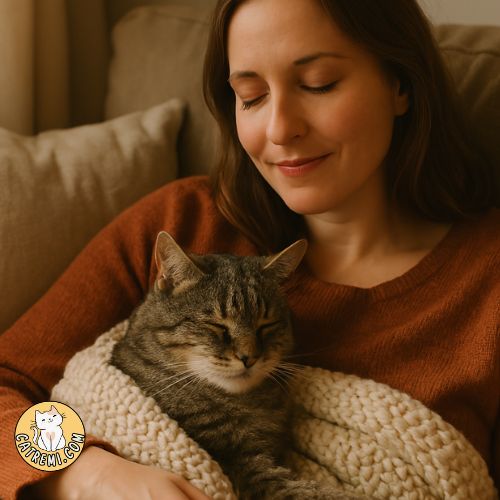🐾 Introduction
As our beloved cats grow older, their needs begin to shift in subtle but meaningful ways. What once worked perfectly—where they slept, how they ate, or even how they moved around the house—may no longer suit their aging bodies. That’s why creating a thoughtful senior cat home setup is one of the most compassionate things we can do for our feline companions in their golden years.
It’s not just about comfort—it’s about preserving their independence, reducing stress on their joints, and ensuring they feel safe, secure, and loved every day. In this guide, we’ll walk you through simple, practical adjustments you can make to your home to support your senior cat’s physical and emotional well-being—starting today.
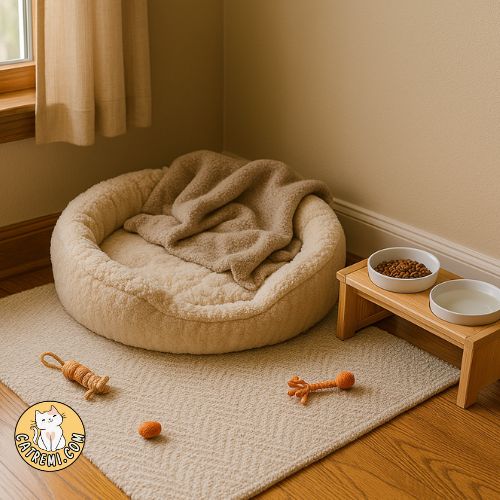
Table of Contents
- 1. Introduction
- 2. Why a Senior Cat Home Setup Matters
- 3. Choosing the Right Location for Rest
- 4. Feeding Area Adjustments
- 5. Litter Box Accessibility
- 6. Safe and Easy Mobility
- 7. Comfort Through Temperature & Lighting
- 8. Mental & Emotional Comfort
- 9. Daily Routines & Familiarity
- 10. Final Thoughts
🛏️ 2. Why a Senior Cat Home Setup Matters
As cats age, they experience a variety of physical changes that can quietly impact how they move, rest, and interact with their environment. Joint stiffness, reduced muscle strength, decreased vision or hearing, and slower reflexes are all part of the natural aging process. These changes may seem subtle at first, but they can greatly affect your cat’s comfort and safety at home.
That’s why creating a thoughtful senior cat home setup is more than just a luxury—it’s a necessity. A well-designed living space helps minimize the risks of injury, such as slipping on hard floors or struggling to reach elevated areas. It also reduces daily stress and anxiety, giving your cat a predictable, peaceful environment where they can thrive in their golden years.
When you adapt your home to meet your senior cat’s evolving needs, you’re not only making life easier for them—you’re actively preserving their independence and dignity. From lower-entry litter boxes to soft bedding in quiet corners, even small changes can make a big difference in preventing falls, supporting mobility, and enhancing emotional well-being.
In short, a proper senior cat home setup provides the foundation for a safe, comfortable, and loving space your cat can call home—no matter their age.
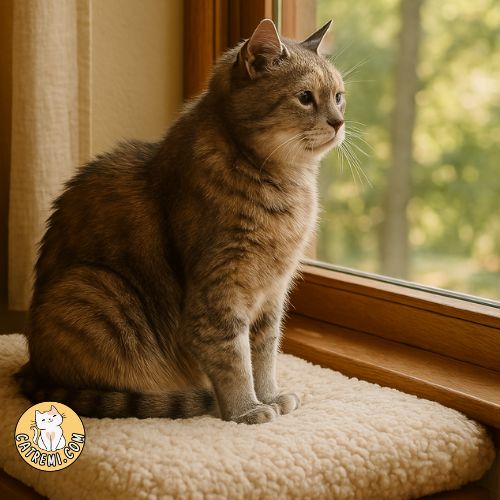
💤 3. Choosing the Right Location for Rest
Rest is one of the most important aspects of a senior cat’s daily life. As cats grow older, they tend to sleep more—sometimes up to 18–20 hours a day—and the quality of that rest plays a key role in their physical and emotional well-being. That’s why choosing the right sleeping area is an essential part of a proper senior cat home setup.
Start by selecting a quiet, low-traffic area in your home where your cat won’t be disturbed by loud noises, drafts, or foot traffic. Senior cats often prefer warm, peaceful spots where they can nap without interruption. Avoid placing beds near cold windows, vents, or damp areas, as older cats are more sensitive to temperature changes and moisture.
When it comes to the bed itself, comfort is key. Look for orthopedic or memory foam beds that provide joint support and relieve pressure on stiff or arthritic limbs. Raised edges can also give your cat a sense of security while they rest.
Place the bed somewhere that’s easy to access—on the floor or near their favorite lounging area—so they don’t have to jump or climb to reach it. If your cat has a favorite sunny spot, that’s a perfect location to create a cozy sleep zone.
A well-chosen resting area doesn’t just help your cat sleep better—it also supports mobility, reduces pain, and enhances their overall comfort. In short, it’s a simple but powerful step in building a compassionate and effective senior cat home setup.
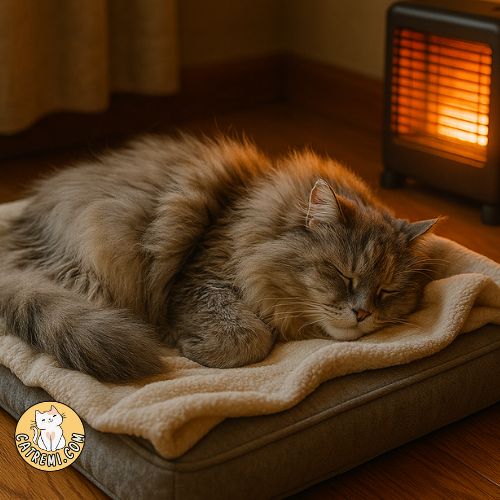
🍽️ 4. Feeding Area Adjustments
As your cat enters their senior years, something as simple as eating can become more challenging. Joint stiffness, reduced mobility, and changes in posture can make bending down or reaching for food uncomfortable. That’s why adjusting the feeding area is a key part of any thoughtful senior cat home setup.
Start by using elevated food and water bowls. These help reduce neck and spine strain, making mealtimes more comfortable—especially for cats with arthritis or limited mobility. Ideally, the bowl should be at chest height, so your cat doesn’t need to crouch or stretch awkwardly.
Choose non-slip bowls that stay firmly in place during feeding. Slipping dishes can cause frustration or anxiety, especially in older cats who are easily startled. Also, avoid deep bowls that might press against your cat’s sensitive whiskers.
Equally important is the placement of the feeding area. Make sure it’s located in a quiet, easily accessible spot—away from loud appliances, foot traffic, or other pets. This helps your senior cat feel safe and relaxed while eating, which can improve their appetite and digestion.
Finally, keep water nearby, or place additional water bowls throughout your home to encourage hydration. Senior cats are more prone to dehydration, especially if they eat primarily dry food.
For more in-depth guidance on choosing the right diet and nutritional support for aging cats, don’t miss our full guide:
👉 Senior Cat Nutrition
A simple adjustment to the feeding area might seem small, but it’s one of the easiest and most effective ways to improve your senior cat home setup and support your cat’s long-term health and happiness.
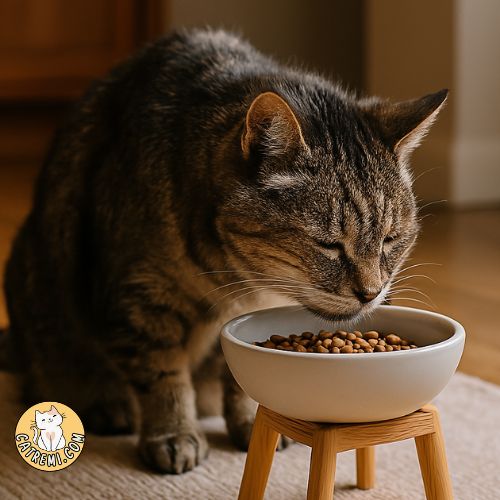
🚽 5. Litter Box Accessibility
As cats age, simple tasks like using the litter box can become physically challenging. Arthritis, joint stiffness, and reduced mobility may make stepping over high edges or navigating long distances more difficult. That’s why making the litter box more accessible is a critical part of an effective senior cat home setup.
One of the easiest adjustments is switching to a low-sided litter box. These are specially designed for senior cats or those with limited mobility, allowing them to enter and exit without pain or hesitation. Avoid covered litter boxes, as they may feel cramped and can trap odors—both of which may deter your aging cat from using them regularly.
Placement is just as important as the design. Ensure the litter box is located in a quiet, easily accessible area without stairs, obstacles, or slippery flooring. Try to keep it on the same floor where your cat spends most of their time. If you have a multi-level home, consider placing a litter box on each floor.
To further enhance comfort and safety, you can add non-slip mats or soft padded supports around the box. This helps prevent sliding and provides gentle cushioning for sore paws and joints.
Monitoring your cat’s litter box habits is also essential, as changes in frequency or behavior may signal health issues common in senior cats, such as kidney disease or arthritis.
Incorporating these small but thoughtful modifications ensures that your senior cat home setup supports your cat’s dignity, comfort, and independence—every day.
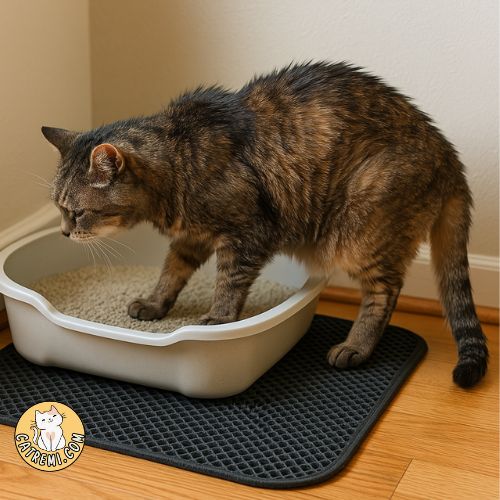
🚶♀️ 6. Safe and Easy Mobility
One of the most overlooked—but essential—aspects of a senior cat home setup is ensuring your aging cat can move around the house comfortably and safely. As cats grow older, they may struggle with jumping, climbing, or navigating slippery surfaces. These mobility issues can lead to stress, reluctance to explore, or even injury.
To support your cat’s independence, consider adding ramps or cat stairs that lead to their favorite elevated spots, such as beds, sofas, or window perches. This allows them to enjoy their usual cozy places without the strain of jumping.
For homes with hardwood or tile floors, place non-slip rugs or carpet runners along walkways and near key areas like feeding stations, litter boxes, and resting spots. These soft surfaces provide traction, reduce the risk of slipping, and offer a little extra cushioning for sensitive joints.
Also, think about the overall layout of your home. Arrange furniture so your cat can navigate smoothly from room to room without needing to leap over obstacles or squeeze through tight spaces. Keep pathways wide and clear, especially in areas they frequent most.
Making your home easier to navigate doesn’t just prevent accidents—it encourages your cat to stay active and engaged. That sense of independence can greatly improve their confidence, mood, and overall well-being.
Incorporating mobility-friendly elements is a powerful way to complete your senior cat home setup, giving your feline friend the freedom and safety they need to age with dignity and comfort.
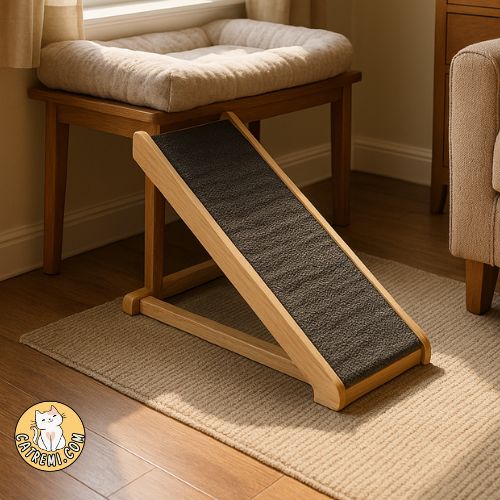
🌡️ 7. Comfort Through Temperature & Lighting
Senior cats are more sensitive to changes in temperature and lighting than younger cats. As they age, their ability to regulate body heat declines, and their vision—especially in low light—can become compromised. That’s why addressing temperature and lighting is a vital part of a complete senior cat home setup.
During colder months, your aging cat may seek out warm surfaces more often. Provide safe, heated options such as low-wattage heating pads, electric blankets with pet-safe features, or thermal self-warming beds. Always ensure that heating products have auto-shutoff and are placed in locations your cat can move away from if they get too warm.
In warm climates or seasons, help your cat stay cool by keeping their favorite resting areas shaded and well-ventilated. Avoid placing beds near windows that get direct afternoon sun unless there’s an option to move to a cooler spot.
Lighting adjustments are also helpful, especially for cats with declining vision. Consider using night lights or dim lamps in key areas like hallways, feeding stations, or near the litter box. This helps your cat navigate more confidently in the dark and prevents accidents or disorientation at night.
By managing temperature and lighting thoughtfully, you’re not just improving your cat’s physical comfort—you’re also supporting their sense of safety and orientation, which can reduce stress and confusion.
These simple changes are a low-cost but high-impact part of any senior cat home setup, helping your beloved feline age with comfort, clarity, and calm.
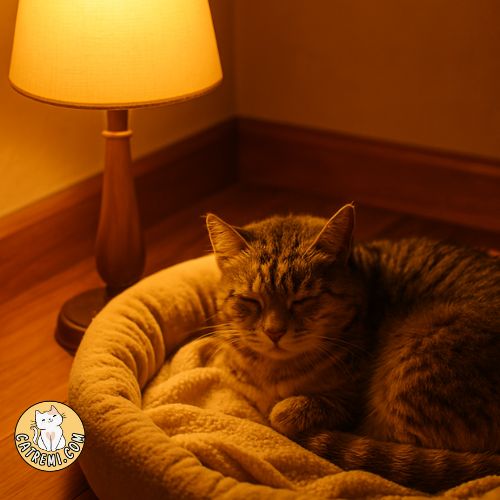
🧠 8. Mental & Emotional Comfort
Caring for a senior cat isn’t just about physical health—it’s about nurturing their heart and mind, too. As cats grow older, they may become less active, more reserved, or even more clingy. That’s why creating a sense of mental and emotional comfort is a deeply important part of any senior cat home setup.
Just like humans, aging cats benefit from gentle stimulation and emotional connection. While they may not chase toys like they used to, they still enjoy low-impact play that engages their curiosity. Soft wand toys, puzzle feeders, and slow-moving interactive games can help keep their minds sharp and spirits high—without requiring too much energy.
Another lovely way to bring joy into your cat’s day is to give them a safe viewing spot by a window or balcony. Whether they’re watching birds flutter, leaves blow, or people walk by, the natural world offers rich, peaceful entertainment. A padded perch or window hammock can quickly become their favorite place to relax.
It’s also helpful to speak softly to your cat, keep routines predictable, and create safe zones where they can retreat when they feel overwhelmed. Some older cats enjoy soft background music or calming scents like lavender (used with care).
These small gestures aren’t small to them—they create an environment where your cat feels secure, seen, and loved.
For more emotional care ideas and tips for daily well-being, don’t miss our full guide:
👉 Senior Cat Care Guide
In the end, the emotional bond you share with your senior cat becomes even more meaningful with time. By nurturing their inner world, you’re giving them the peace and happiness they deserve in their golden years.
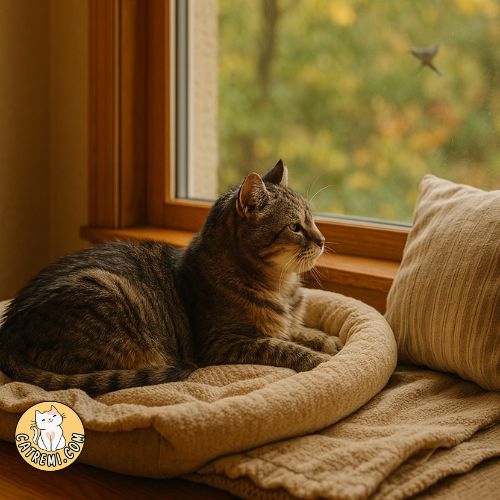
🕐 9. Daily Routines & Familiarity
For senior cats, comfort doesn’t just come from soft beds or gentle lighting—it also comes from the predictability of routine. As cats age, they often become more sensitive to change, both physically and emotionally. Sudden shifts in their environment or daily schedule can cause confusion, stress, and even impact their health.
That’s why maintaining familiarity in your senior cat’s routine is one of the most loving things you can do.
Start with the basics: try not to change the location of their food and water bowls, litter box, or resting areas unless absolutely necessary. These are their anchors—the safe zones they rely on to feel secure each day. Even small changes, like moving a favorite bed or altering feeding times, can unsettle an older cat more than we realize.
Incorporating gentle, consistent activities into their daily life can also bring a lot of joy and emotional connection. This might include:
- A quiet brushing session after breakfast
- A soft-spoken “good morning” ritual
- A bit of cozy cuddle time before bed
These small moments create a rhythm your cat can trust, helping them feel grounded and loved—especially as their world naturally becomes slower and more limited.
If your cat seems more withdrawn or anxious lately, try returning to old familiar habits or sounds. Sometimes, simply playing a song they’ve heard for years or sitting quietly in their favorite spot can ease their mind.
In the end, a stable routine is more than structure—it’s emotional safety. And within a thoughtful senior cat home setup, those little daily consistencies are what turn a house into a true sanctuary.
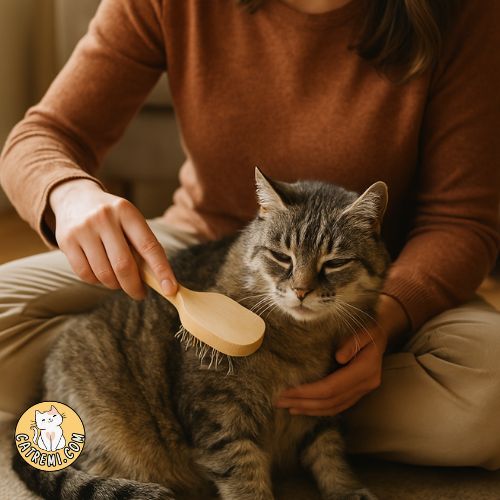
💬 10. Final Thoughts
Creating a loving senior cat home setup is not just about physical adjustments—it’s an act of quiet devotion. It’s how we say, without words, “You’re safe here. You’re still valued. You’re still deeply loved.”
From soft beds and accessible litter boxes to familiar routines and comforting lighting, each choice we make adds a layer of care. And together, these layers build a world where your senior cat can continue to thrive—not just survive.
At this stage in their life, our feline companions may move a little slower, sleep a little longer, or ask for attention in gentler ways. But what hasn’t changed is their need for comfort, connection, and a space that feels truly like home.
If you’ve made even one small change after reading this guide, you’ve already taken a step toward enriching your cat’s golden years. And if your heart feels full thinking about the soft purrs and slow blinks that come from a cat who feels truly at peace—know that you’re doing beautifully.
We’d love to hear from you:
🐱 Have you created a cozy corner for your senior cat?
📸 Want to share a photo of their favorite resting spot or routine?
Feel free to share your story in the comments—we believe in learning from one another, and your experience might inspire another cat parent to start their own journey.
✅ Want to give your senior cat even more love and comfort?
Don’t miss our full guides here:
Thank you for giving your cat not just a home—but a home that listens, adapts, and loves them through every stage of life. 🐾💛
